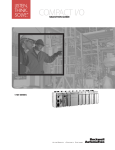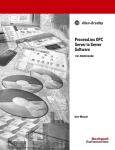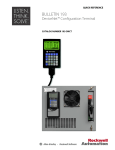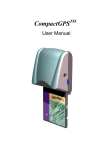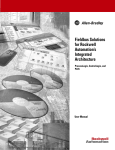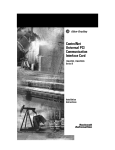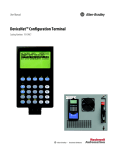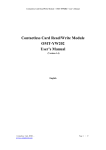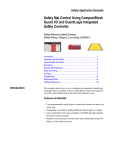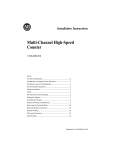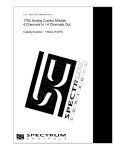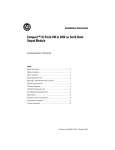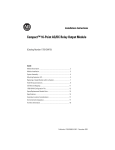Download 1756-AT007-EN-P, Integrating DeviceNet into
Transcript
Integrating DeviceNet into ProcessLogix* 1756-DNB, 1757 Series *ProcessLogix R510.0 and above. Application Technique Important User Information Because of the variety of uses for the products described in this publication, those responsible for the application and use of these products must satisfy themselves that all necessary steps have been taken to assure that each application and use meets all performance and safety requirements, including any applicable laws, regulations, codes and standards. In no event will Rockwell Automation be responsible or liable for indirect or consequential damage resulting from the use or application of these products. Any illustrations, charts, sample programs, and layout examples shown in this publication are intended solely for purposes of example. Since there are many variables and requirements associated with any particular installation, Rockwell Automation does not assume responsibility or liability (to include intellectual property liability) for actual use based upon the examples shown in this publication. Allen-Bradley publication SGI-1.1, Safety Guidelines for the Application, Installation and Maintenance of Solid-State Control (available from your local Rockwell Automation office), describes some important differences between solid-state equipment and electromechanical devices that should be taken into consideration when applying products such as those described in this publication. Reproduction of the contents of this copyrighted publication, in whole or part, without written permission of Rockwell Automation, is prohibited. Throughout this publication, notes may be used to make you aware of safety considerations. The following annotations and their accompanying statements help you to identify a potential hazard, avoid a potential hazard, and recognize the consequences of a potential hazard: WARNING ! ATTENTION ! IMPORTANT Identifies information about practices or circumstances that can cause an explosion in a hazardous environment, which may lead to personal injury or death, property damage, or economic loss. Identifies information about practices or circumstances that can lead to personal injury or death, property damage, or economic loss. Identifies information that is critical for successful application and understanding of the product. Allen-Bradley is a trademark of Rockwell Automation Table of Contents Important User Information . . . . . . . . . . . . . . . . . . . . . . . . . . . . . . . . . . ii Preface Minimum Hardware Requirements for ProcessLogix R510.0 . ProcessLogix Online User Documentation and Knowledge Builder. . . . . . . . . . . . . . . . . . . . . . . . . . . Terminology . . . . . . . . . . . . . . . . . . . . . . . . . . . . . . . . . . . . . . . . Conventions . . . . . . . . . . . . . . . . . . . . . . . . . . . . . . . . . . . . . . . . Terms and Type Representations . . . . . . . . . . . . . . . . . . . . Preface-1 Preface-1 Preface-1 Preface-3 Preface-3 Chapter 1 Introduction Prerequisites . . . . . . . . . . . . . . . . . . . . . . . . . . . . . . . . . . . . . . . . . . . . . General Checklist to Configure a 1756-DNB in ProcessLogix . . . . . 1756-DNB DeviceNet Interface Module . . . . . . . . . . . . . . . . . . . . . . Example Topology for Integrating DeviceNet into ProcessLogix R510.0 . . . . . . . . . . . . . . . . . . . . . . . . . . DeviceNet Interface to a Non Redundant Controller . . . . . . . . . DeviceNet Interface to a Redundant Controller . . . . . . . . . . . . . System Performance, Capacity and Topology Specifications. . . . . . . 1-1 1-1 1-2 1-3 1-3 1-4 1-5 Chapter 2 ProcessLogix R510.0 Function Block Set Architecture DeviceNet Library . . . . . . . . . . . . . . . . . . . . . . . . . . . . . . . . . . . . . . . . DNETIF Library . . . . . . . . . . . . . . . . . . . . . . . . . . . . . . . . . . . . . . Function Block Set. . . . . . . . . . . . . . . . . . . . . . . . . . . . . . . . . . . . . DNET_IM . . . . . . . . . . . . . . . . . . . . . . . . . . . . . . . . . . . . . DNET_DEVICE . . . . . . . . . . . . . . . . . . . . . . . . . . . . . . . . DNET_INCHAN . . . . . . . . . . . . . . . . . . . . . . . . . . . . . . . DNET_OUTCHAN . . . . . . . . . . . . . . . . . . . . . . . . . . . . . Configuration Tools. . . . . . . . . . . . . . . . . . . . . . . . . . . . . . . . . . . . 1756-DNB . . . . . . . . . . . . . . . . . . . . . . . . . . . . . . . . . . . . . . DNETIF Library . . . . . . . . . . . . . . . . . . . . . . . . . . . . . . . . . DeviceNet Wizard . . . . . . . . . . . . . . . . . . . . . . . . . . . . . . . . DeviceNet Network Configuration . . . . . . . . . . . . . . . . . . 2-1 2-1 2-2 2-2 2-2 2-2 2-3 2-3 2-3 2-3 2-3 2-3 Chapter 3 Using the 1756-DNB and ProcessLogix to Communicate with Flex I/0 1 Prerequisites . . . . . . . . . . . . . . . . . . . . . . . . . . . . . . . . . . . . . . . . . . . . . 3-1 Getting Started in Control Builder . . . . . . . . . . . . . . . . . . . . . . . . . . . 3-1 Creating and Configuring the CPM. . . . . . . . . . . . . . . . . . . . . . . . . . . 3-2 Creating a DNET_IM Module . . . . . . . . . . . . . . . . . . . . . . . . . . . . . . 3-2 Locate Mapping Data from RSNetworx. . . . . . . . . . . . . . . . . . . . 3-8 Create a DNET_DEVICE . . . . . . . . . . . . . . . . . . . . . . . . . . . . . . . . 3-14 Configure Input and Output Channels . . . . . . . . . . . . . . . . . . . . . . . 3-19 Create a new CM . . . . . . . . . . . . . . . . . . . . . . . . . . . . . . . . . . . . . 3-19 Set-up communication with the 1794-IE8/1794-OE4 pair . . . 3-20 Input Channel . . . . . . . . . . . . . . . . . . . . . . . . . . . . . . . . . . 3-20 Output Channel . . . . . . . . . . . . . . . . . . . . . . . . . . . . . . . . 3-21 Publication 1756-AT007B-EN-P - August 2003 Table of Contents 2 Set-up communication with the 1794-IB32/1794-OB32 pair. . Input channels . . . . . . . . . . . . . . . . . . . . . . . . . . . . . . . . . . Output Channels . . . . . . . . . . . . . . . . . . . . . . . . . . . . . . . . Set-up communication with the 1794-IF4I/1794-OF4I pair. . . Input Channels . . . . . . . . . . . . . . . . . . . . . . . . . . . . . . . . . Output Channels . . . . . . . . . . . . . . . . . . . . . . . . . . . . . . . 3-23 3-23 3-24 3-25 3-26 3-26 Chapter 4 Troubleshooting Hardware . . . . . . . . . . . . . . . . . . . . . . . . . . . . . . . . . . . . . . . . . . . . . . . 1756-DNB . . . . . . . . . . . . . . . . . . . . . . . . . . . . . . . . . . . . . . . . . . . DNB Error Codes . . . . . . . . . . . . . . . . . . . . . . . . . . . . . . . . Software . . . . . . . . . . . . . . . . . . . . . . . . . . . . . . . . . . . . . . . . . . . . . . . . RSNetworx for DeviceNet . . . . . . . . . . . . . . . . . . . . . . . . . . . . . . Changing Hardware . . . . . . . . . . . . . . . . . . . . . . . . . . . . . . Control Builder . . . . . . . . . . . . . . . . . . . . . . . . . . . . . . . . . . . . . . . Device is red but IM is green . . . . . . . . . . . . . . . . . . . . . . . Configuration mismatch error on download . . . . . . . . . . . Data not reflected in module or device . . . . . . . . . . . . . . . 4-1 4-1 4-1 4-1 4-1 4-1 4-1 4-1 4-1 4-1 Backcover Rockwell Automation Support . . . . . . . . . . . . . . . . . . . . . . . . . . . . . . BC Installation Assistance . . . . . . . . . . . . . . . . . . . . . . . . . . . . . . . . . . BC New Product Satisfaction Return . . . . . . . . . . . . . . . . . . . . . . . . . BC Publication 1756-AT007B-EN-P - August 2003 Preface Minimum Hardware Requirements for ProcessLogix R510.0 The DeviceNet Interface Library is only supported by ProcessLogix R510.0. ProcessLogix R510.0 Server Software must be installed on a PC that is specifically qualified. Use of any other PC variations will render the standard warranty and support agreement null and void. ProcessLogix Online User Documentation/Knowledge Builder ProcessLogix online user documentation is included with your ProcessLogix system in browser format through the Knowledge Builder. Most of the documents may also be ordered individually through Rockwell Automation in print format, visit us at: www.theautomationbookstore.com. Knowledge Builder provides the user with task-based documentation within the Server and Client stations and may be accessed while using any of ProcessLogix’s software programs. Knowledge Builder’s internal links and search functions allow the user to access process relevant information and references. References to Knowledge Builder throughout this document are illustrated as: Navigate in Knowledge Builder to Ethernet Implementation Guide⇒Configuration⇒Setting Up Drivers and IP Addresses for more information. Terminology Table P.1 Terminology used in this Application Technique 1 Term Definition CNB ControlNet Interface Module ICP Integrated Control Platform CEE Control Execution Environment IOC Input Output Channel IOM Input Output Module IOC FB Input Output Channel Function Block IOM FB Input Output Module Function Block Publication 1756-AT007B-EN-P - August 2003 Preface 2 Table P.1 Terminology used in this Application Technique Publication 1756-AT007B-EN-P - August 2003 Term Definition DNET DeviceNet Interface Module, specifically the 1756-DNB ODVA Open DeviceNet Vendor Association They provide comprehensive DeviceNet support and documentation, contact www.odva.com. You can also refer to www.theautomationbookstore.com to order or download Devicenet documentation from Rockwell. Such as the DeviceNet Planning and installation Guide, DeviceNet Overviews and Selection Guides and well as a DeviceNet Starter Kit. EDS Electronic Data Sheets .dll’s that RSNetWorx requires to be able to identify the devices. You can obtain these files in many ways. Shipped with device, through the manufacturers web site and for many are at www.ab.com. Preface Conventions 3 Terms and Type Representations The following table summarizes the terms and type representation conventions used in this Guide. Term/Type Representation Meaning Example click, click on, click [button name] Click left mouse button once. (Assumes cursor is positioned on object or selection.) Click Browse. double-click Click left mouse button twice in quick succession. (Assumes cursor is positioned on object or selection.) Double-click the Station icon. drag Press and hold left mouse button Drag the PID function block while dragging cursor to new onto the Control Drawing. screen location and then release the button. (Assumes cursor is positioned on object or selection to be moved.) right-click Click right mouse button once. (Assumes cursor is positioned on object or selection.) Right-click the AND function block. select click to highlight a menu item or list choice, or click on a button. Select Configure Allen-Bradley drivers from the list box. <F1> Keys to be pressed are shown in angle brackets. Press <F1> to view the online Help. <Ctrl>+<C> Keys to be pressed together are shown with a plus sign. Press <Ctrl>+<C> to close the window. File⇒New Shows menu selection as menu name followed by menu selection. Click File⇒New to start new drawing. >D:\setup.exe< Data to be keyed in at prompt or in an entry field. Enter this path location >D:\setup.exe<. Publication 1756-AT007B-EN-P - August 2003 Preface 4 Notes: Publication 1756-AT007B-EN-P - August 2003 Chapter 1 Introduction Prerequisites This document describes how to define, configure and monitor a DeviceNet network using the DeviceNet Interface Library. This Quick Start assumes that you have an understanding of basic Control Builder terminology, control strategies as well as an understanding of DeviceNet terminology and configuration tools. The following checklist describes what is required of you before you begin integrating a DeviceNet Device into your ProcessLogix R510.0 system. General Checklist to Configure a 1756-DNB in ProcessLogix Table 1.A General Checklist to Configure a 1756-DNB in ProcessLogix ✔ You must have: Purchased or upgraded to appropriate hardware to run ProcessLogix R510.0. ProcessLogix R510.0 with the DNET Interface Library installed. • The DNET Library is integrated into ProcessLogix R510.0. • If you have purchased the ProcessLogix Hardware from Rockwell Automation, this library has been installed on the Server shipped from the factory. • If you are upgrading existing hardware or using your hardware configured to ProcessLogix R510.0 specifications, then follow the installation instructions in the ProcessLogix R510.0 Installation and Upgrade Guide, publication 1757-IN510A-EN-P. A DeviceNet network, wired properly and working. All devices on the DeviceNet network assigned to the DeviceNet interface module and no errors are showing in the LED display. A working knowledge or have access to the support of a person with working knowledge of Control Builder and RSNetWorx for DeviceNet. RSNetWorx installed and running properly on your development machine. RSNetWorx configuration information: • Input mapping • Output mapping 1 Publication 1756-AT007B-EN-P - August 2003 1-2 Introduction Table 1.A General Checklist to Configure a 1756-DNB in ProcessLogix ✔ You must have: Slot locations of 1756-DNBs that you plan on monitoring through ProcessLogix • Controller locations • Device Addresses Experience programming Function Blocks in Control Builder • Attend hands-on training classes • Obtain help from a knowledgeable source Identified or installed the 1756-DNB. 1756-DNB DeviceNet Interface Module The 1756-DNB: • provides a communication bridge between ControlNet and DeviceNet • utilizes the Rockwell 1756 form factor, which is native to ProcessLogix • can be located in either the ProcessLogix Controller Rack or I/O Rack • supports the three DeviceNet baud rates: 500 KBps, 250 KBps and 125KBps. • is configured from a PC running the RSNetWorx for DeviceNet configuration tool connected to either DeviceNet through a 1770-KFD Interface Module or ControlNet through a CNB. • input and output messages from/to the various DeviceNet devices are bundled at the ControlNet level into 2 assemblies (data objects) which are available for transport across ControlNet from/to the 1757-PLX52 Controller: • as configured with the DeviceNet network configuration, all input data messages (from DeviceNet input devices) are packed into a 496 byte input assembly. Input data is bound from input devices to the 1757-PLX52 Controller. • as configured with the DeviceNet network configuration, all output data messages (to DeviceNet output devices) are packed into a 492 byte output assembly. Output data is bound from the 1757-PLX52 Controller to the output device. Publication 1756-AT007B-EN-P - August 2003 Introduction Example Topology for Integrating DeviceNet into ProcessLogix R510.0 1-3 The DeviceNet Interface module can be supported in both Redundant and Non-Redundant Controller topologies. The following diagrams depict the intended ProcessLogix DeviceNet interface in these hardware topologies. DeviceNet Interface to a Non Redundant Controller • The 1756-DNB is the DeviceNet Interface module. • The PC with the RSNetWorx Configuration Tool is used to configure the DeviceNet Interface Module and the DeviceNet network. • Although ControlNet is depicted for the supervisory network, Ethernet supervisory networks are also possible. • In a non-redundant configuration the 1756-DNB may reside in the controller chassis or in the I/O chassis. • Although only one DeviceNet Interface is shown, a PLX controller can host multiple modules. Refer to 1-5. Publication 1756-AT007B-EN-P - August 2003 1-4 Introduction DeviceNet Interface to a Redundant Controller • The 1756-DNB is the DeviceNet Interface module. • The PC with the RSNetWorx Configuration Tool is used to configure the DeviceNet Interface Module and the DeviceNet network. • In a redundant configuration the DeviceNet Interface resides in the I/O chassis. There are no Ethernet modules qualified for use with SRM’s. • Although only one DeviceNet Interface is shown, a PLX controller can host multiple modules. Refer to 1-5. Publication 1756-AT007B-EN-P - August 2003 Introduction System Performance, Capacity and Topology Specifications 1-5 Following are the performance, capacity and topology specifications applicable when implementing the DeviceNet Interface in a ProcessLogix system. The information in this section is intended to supplement the ProcessLogix Installation and Upgrade Guide. For more information about Integrating DeviceNet and ProcessLogix, navigate in Knowledge Builder to CCL Help⇒DeviceNet Interface. The 1756-DNB is not a redundancy compliant device and therefore cannot be introduced into a controller rack of a redundant controller configuration. However in non-redundant applications, the module can be deployed in either the controller rack or a downlink I/O rack. • The communication update interval between the DeviceNet Interface and the DNET_IM block is not configurable, but is dependant upon the Base Execution Rate of the CEE in which the block is running. Table 1.2 CEE Base Execution Rate Input Rate Output Rate 50 Ms 25 Ms 25 Ms 5 Ms 5 Ms 5 Ms • Up to four 1756-DNB modules can reside in the local rack and/or in a remote rack. This configuration has been tested and is currently supported. • The DNET_IM block supports communication to a maximum of 64 unique DeviceNet devices, identified by a unique network address within the valid network address range of 0-63. • The DeviceNet Interface imposes the following constraints, which may restrict the number of DeviceNet devices supported: – The sum of all input message sizes from all input devices cannot exceed 496 bytes. – The sum of all output message sizes from all output devices cannot exceed 492 bytes. • Regarding the existing system limit of 64 IOM connections per PLX and 24 IOM's per downlink CNB: – The DNET_IM block is the equivalent of 2 IOM's in this calculation – The DNET_DEVICE blocks that are associated with a given DNET_IM block are not counted in these limits. (Only the associated DNET_IM block is counted.) • Supported DeviceNet baud rates: 500 KBps, 250 KBps and 125KBps Publication 1756-AT007B-EN-P - August 2003 1-6 Introduction Notes: Publication 1756-AT007B-EN-P - August 2003 Chapter 2 ProcessLogix R510.0 Function Block Set Architecture DeviceNet Library The set of function blocks that comprise the ProcessLogix DeviceNet library are packaged as a Control Component Library (CCL). The CCL requires ProcessLogix R510.0 to run. DNETIF Library All DeviceNet blocks are contained in the DNETIF (DeviceNet Interface) library of the ProcessLogix database. 1 Publication 1756-AT007B-EN-P - August 2003 2-2 ProcessLogix R510.0 Function Block Set Architecture Function Block Set The DNETIF library comprises the following blocks: Templates Function Blocks DNET_IM DNET_IM is a template, an IOM block that represents a DeviceNet Interface module. This template allows ProcessLogix to communicate/monitor a DeviceNet device via the 1756-DNB, such as any I/O, Flex, or MicroLogix. DNET_DEVICE DNET_DEVICE is a template, a generic block that represents a DeviceNet device present on the DeviceNet network connected to the DeviceNet Interface Module. DNET_INCHAN DNET_INCHAN is a generic input channel block template that represents individual input data read from the DeviceNet devices. This block can be configured to create an interface to all DeviceNet devices. Simply, this function block receives input data from the 1756-DNB that has been sent from the DeviceNet device. Publication 1756-AT007B-EN-P - August 2003 ProcessLogix R510.0 Function Block Set Architecture 2-3 DNET_OUTCHAN DNET_OUTCHAN is a generic output channel block template that represents individual output data to the DeviceNet devices. This block can be configured to create an interface to all DeviceNet devices. Simply, this function block sends output data from ProcessLogix to the device through a 1756-DNB. Configuration Tools Each of the affected hardware components in the ProcessLogix/DeviceNet architecture require the use of specific configuration tools as listed in the table below: Table 2.1 Configuration Tools Component Configuration Tool 1756-DNB Module RSNetworks for DeviceNet DeviceNet Devices RSNetworks for DeviceNet All ProcessLogix Blocks ProcessLogix Control Builder DeviceNet I/O Module Function Blocks DeviceNet Wizard, optional 1756-DNB Verify that your Rockwell 1756-DNB DeviceNet Interface Module is at firmware release 3.010 or later. DNETIF Library Use of the DeviceNet Interface module with the DNETIF library requires the purchase of one license for each interface module used. DeviceNet Wizard The ProcessLogix DeviceNet Wizard takes the report file of the network created in RSNetworx and creates Device and IM blocks that can be imported into ControlBuilder. Navigate in Knowledge Builder to ProcessLogix R510⇒CCL Help⇒DeviceNet Interface for detailed information. DeviceNet Network Configuration The DeviceNet network is configured using the RSNetworks for DeviceNet configuration tool. This tool, including supporting documentation is purchased as a separate license. Although this document includes some examples of DeviceNet configuration, it does not attempt to duplicate the information provided in the RSNetworks for DeviceNet or any other DeviceNet documentation. Publication 1756-AT007B-EN-P - August 2003 2-4 ProcessLogix R510.0 Function Block Set Architecture Notes: Publication 1756-AT007B-EN-P - August 2003 Chapter 3 Using the 1756-DNB and ProcessLogix to Communicate with Flex I/0 Prerequisites The following checklist describes what is required of you before you begin integrating a DeviceNet device into your ProcessLogix R510.0 system. ✔ Getting Started in Control Builder Step Item Refer to: 1. Getting Started in Control Builder 3-1 2. Creating and Configuring the CPM 3-2 3. Creating a DNET_IM Module 3-2 4. Locate Mapping Data from RSNetworx 3-8 5. Create a DNET_DEVICE 3-14 6. Configure Input and Output Channels 3-19 1. Open Control Builder. 2. In Control Builder, have two tree windows open: • Project • Monitoring 1 Publication 1756-AT007B-EN-P - August 2003 3-2 Using the 1756-DNB and ProcessLogix to Communicate with Flex I/0 Creating and Configuring the CPM 3. Create a CPM, (ProcessLogix Controller representation) if you don’t already have one to use, select File ⇒ New ⇒ Controllers ⇒ CPM. 4. Configure the CPM, enter the required information. 5. Download the CPM. Creating a DNET_IM Module This procedure will create a representation of the 1756-DNB Module in the I/O list for the CPM. 1. Select the Library tab. Publication 1756-AT007B-EN-P - August 2003 Using the 1756-DNB and ProcessLogix to Communicate with Flex I/0 3-3 2. Find and expand DNETIF library. You see: 3. Select the DNET_IM and drag it on to the CEE in the Tree Window Project Tab. Publication 1756-AT007B-EN-P - August 2003 3-4 Using the 1756-DNB and ProcessLogix to Communicate with Flex I/0 You see: TIP To create a new DNET_IM, you can use the menus instead of dragging the DNET_IM onto the CEE: Select File ⇒ New ⇒ I/O Modules ⇒ DNETIF ⇒ DNET_IM - DeviceNet Interface Module. Then assign it to the appropriate CEE. 4. Click Finish. 5. Expand the CEE. 6. Expand the I/O modules. 7. Double-click on the DNET_IM that was just created. Publication 1756-AT007B-EN-P - August 2003 Using the 1756-DNB and ProcessLogix to Communicate with Flex I/0 3-5 You will see. 8. Create a name. 9. Enter the rack address of the 1756-DNB module that you want to communicate with. The other fields are used for remote rack locations. 1756-DNB in slot 4 10. Select the Interface Module tab. You see: In this instance the DeviceNet address of the 1756-DNB is 4. 11. Enter the information for the DeviceNet Address of the 1756-DNB. 12. Click OK. 13. Go to the Project tab window. 14. Select the DNET_IM that you configured. Publication 1756-AT007B-EN-P - August 2003 3-6 Using the 1756-DNB and ProcessLogix to Communicate with Flex I/0 Download the DNET_IM to the processor by clicking . You see the item loaded: 15. Click OK. 16. Go to the Monitoring tab window. 17. Select the CEE. 18. Activate the CEE either by right clicking and selecting the following: 19. Go to the I/O section and verify that the DNET_IM is green. 20. Double-click on the selected DNET_IM. Publication 1756-AT007B-EN-P - August 2003 Using the 1756-DNB and ProcessLogix to Communicate with Flex I/0 3-7 Publication 1756-AT007B-EN-P - August 2003 3-8 Using the 1756-DNB and ProcessLogix to Communicate with Flex I/0 21. Go to the Command Status tab and change the Command Register from Idle to Run Mode. Locate Mapping Data from RSNetworx RSNetworx for DeviceNet can indicate where all data is mapped. 1. Go to RSNetworx for DeviceNet 2. Go Online by clicking this button, Publication 1756-AT007B-EN-P - August 2003 , in toolbar. Using the 1756-DNB and ProcessLogix to Communicate with Flex I/0 3-9 Publication 1756-AT007B-EN-P - August 2003 3-10 Using the 1756-DNB and ProcessLogix to Communicate with Flex I/0 Your screen should display a network similar to this one. 3. Double click the 1756-DNB icon and select the Scanlist tab A 1794-ADN (Flex I/O DeviceNet adapter) is already in the Scanlist for 1756-DNB. If it is not, use the arrow buttons to assign it to your DeviceNet interface module. 4. Click Apply, if changes have been made, to download these changes to the DNB module. 5. Click on the Input tab to access the mapping data for the input assembly of the DNB. Publication 1756-AT007B-EN-P - August 2003 Using the 1756-DNB and ProcessLogix to Communicate with Flex I/0 3-11 The Input tab shows where the data is located in the DeviceNet interface modules’ memory. The 1794-DNBs input assembly has these characteristics: Data Offset (Double Words): 0 Data Offset (Bits): 24 Length (Bits): 304 (38 bytes*8 bits per byte) 6. Click the Output tab to view the output data assembly. From RSNetworx, the data assemblies are assigned as one large chunk. The memory space of each individual module is not delineated in the memory of the DNB. The output assembly for the ADN has these characteristics: Data Offset (Double Words): 0 Data Offset (Bits): 0 Length (Bits): 192 (24bytes*8 bits per byte) To see how the individual Flex I/O modules are mapped you need to view the memory of the ADN. Publication 1756-AT007B-EN-P - August 2003 3-12 Using the 1756-DNB and ProcessLogix to Communicate with Flex I/0 7. Double click on the ADN icon in the network display screen to see its configuration 8. Click the Module Configuration tab to view the Flex I/O modules From the Module Configuration tab each module can be configured (channel config, mode, etc.). The two Generic Modules seen here are a 1794-IB32 and a 1794-OB32. Even though RSNetworx does not recognize these modules, we are able to use them via DeviceNet. Publication 1756-AT007B-EN-P - August 2003 Using the 1756-DNB and ProcessLogix to Communicate with Flex I/0 3-13 9. Click the Summary tab to see the data mapping for each module. The Summary tab explains exactly where you need to point to in the DeviceNet interface modules’ memory to access each Flex I/O module. You now have sufficient data from RSNetworx to setup your DNET_DEVICE block properly in ProcessLogix. Publication 1756-AT007B-EN-P - August 2003 3-14 Using the 1756-DNB and ProcessLogix to Communicate with Flex I/0 Create a DNET_DEVICE Now that you have a working DNET_IM module, you need to create a DNET_DEVICE that will be associated with the new DNET_IM. 1. Go to the Library tab window. 2. Locate DNETIF and then DNET_DEVICE. You see: 3. Select the DNET_DEVICE and drag it up to the CEE in the Project tab window. 4. Click File ⇒ New ⇒ DNETIF ⇒ DNET_DEVICE. Publication 1756-AT007B-EN-P - August 2003 Using the 1756-DNB and ProcessLogix to Communicate with Flex I/0 3-15 5. Give your DNET_DEVICE a unique name. 6. Click Finish to continue (for this example the name of the device is Test_21_DV_2). 7. Double click on the new icon for Test_21_DV_2 in the project window. Publication 1756-AT007B-EN-P - August 2003 3-16 Using the 1756-DNB and ProcessLogix to Communicate with Flex I/0 You see: 8. Enter a Description. 9. Select the Module Configuration tab. Publication 1756-AT007B-EN-P - August 2003 Using the 1756-DNB and ProcessLogix to Communicate with Flex I/0 3-17 You see a similar screen. 10. Enter the DeviceNet I/F Module Name as the name of the DNET_IM that has this DeviceNet device (Test_21_DV_2) in it's scanlist. This example is DNET_IM module is Test 4621. 11. Enter the DeviceNet Address of the 1794-ADN. Refer to Locate Mapping Data from RSNetworx on page 3-8. 12. Enter the Input Data Format. refer back to page 3-11, where we recorded this data from RSNetworx. In this example the correct information has been entered. The input assembly does not need to be separated by device because you can read data from the DeviceNet interface module as many times as you want, it does not interfere with the communication to and from the device. IMPORTANT This screen may read Data Offset (Words); however, this is a reference to a data size of 32 bits and is changed in R510.0 to read Data Offset (Double Words). Data Offset (Double Words): 0 Data Offset (Bits): 24 Length (Bits): 304 (38 bytes*8 bits per byte) Publication 1756-AT007B-EN-P - August 2003 3-18 Using the 1756-DNB and ProcessLogix to Communicate with Flex I/0 13. For the output data assembly you need to separate the large chunk of data into module specific chunks. You need to have one space for OE4 data, one space for the OB32 data, and one space for the OF4I data. This allows you to write to all three data spaces simultaneously with no overlap. The scanlist information from RSNetworx tells us the size and location of the entire chunk of data. Data Offset (Double Words): 0 Data Offset (Bits): 0 Length (Bits): 192 (24 bytes *8 bits per byte) Information from the 1794-ADN further defines the spaces of memory to create. Refer to the Summary tab example in Step 9 on page 9. Based on the data shown here, this configuration provides access to each Flex output module. Following is the data provided in the example: OE4 This module appears at the beginning of the output assembly and is assigned 4 words of data. Data Offset (Double Words): 0 Data Offset (Bits): 0 Length (Bits): 80 5 words (* 2 bytes per word * 8 bits per byte) 80 bits is actually 5 words of data, the fifth word is not used in this example. and included for so that all bits of data were accounted for. OB32 (appears as Generic Module) - This module appears next (an offset of 80 bytes corresponds to 2 32-bit double words and 16 bits) and is assigned 2 words of data. Data Offset (Double Words): 2 OF4I Data Offset (Bits): 16 Length (Bits): 32 2 words (*2 bytes per word * 8 bits per byte) This module has an offset of 112 (80 plus 32) and will complete the output assembly with 5 words of data. Data Offset (Double Words): 3 Data Offset (Bits): 16 Length (Bits): 80 5 words (* 2 bytes per word * 8 bits per byte) The entire output assembly (192 bits) is accounted for and each output module has a separate space. Publication 1756-AT007B-EN-P - August 2003 Using the 1756-DNB and ProcessLogix to Communicate with Flex I/0 3-19 14. Save this configuration by clicking OK once you have finished entering this data. 15. Download and activate the DNET_DEVICE. Once these steps are complete Input and Output channels may be configured to map to these locations. Configure Input and Output Create a new CM Channels 1. Go to the Project tab. 2. Click File ⇒ New ⇒ Control Module. This new CM should appear in the Unassigned section of the Project tab. 3. Give it a unique name (ours is called Flex_Analog). 4. Assign it to the CPM to which your DNET_IM blocks and DNET_DEVICE are assigned. If your blocks are all unassigned, you should do so at this time. If necessary create a new CPM. 5. Click on the CM to drag and drop function blocks into it. Publication 1756-AT007B-EN-P - August 2003 3-20 Using the 1756-DNB and ProcessLogix to Communicate with Flex I/0 Set-up communication with the 1794-IE8/1794-OE4 pair Input Channel 6. Drag and drop a DNET_INCHAN from the Library tab. 7. Double click the block to display the block parameters form. 8. Select the appropriate Module Name from the drop down list to associate this input channel with the correct device. 9. Click Assign Channel Block to complete the association. Your screen should look similar to the above picture when you are finished. You can chose any available channel to assign, it does not need to be channel 5. 10. Select the Input Data Location tab. Publication 1756-AT007B-EN-P - August 2003 Using the 1756-DNB and ProcessLogix to Communicate with Flex I/0 3-21 11. Enter the correct information to match the Input Data Format table on the Module Configuration tab for the DNET_DEVICE block. Refer to Locate Mapping Data from RSNetworx on page 3-8, for the module configuration example. IMPORTANT This data MUST match what is entered into the Input Data Format table in the DNET_DEVICE block or the input channel will not operate. Use Steps 6-11 to configure the way that the Main and Input Data Location tabs for all input channels for this device (the ADN adapter). Use the Numeric Input Config tab or Discrete Input Config tab to indicate offsets for each individual module. 12. Select the Numeric Input Config. tab. The byte offset column indicates the location in the input data assembly that we are attempting to read. This offset is relative to the Input Data Location that was specified in the Input Data Location tab. In this example, the input of the IE8 is the first module in the data assembly. Therefore in this case we are reading in the general ADN status word and the first 2 bytes of data from the IE8. Refer to page 3-13 for RSNetworx data. 13. Select the desired number of numeric inputs for this block and set offsets accordingly (if you are using discrete modules, see the next example on page 3-23) 14. Click OK to save changes and exit block parameters. Output Channel 1. Drag and drop a DNET_OUTCHAN block from the Library tab. 2. Double click on the block to display the block parameters form. Publication 1756-AT007B-EN-P - August 2003 3-22 Using the 1756-DNB and ProcessLogix to Communicate with Flex I/0 3. Assign the block to the DNET_DEVICE just as you did for the Input channel. 4. Select the Output Data Location tab. 5. Enter the correct information to match the Output Data Format table on the Module Configuration tab for your device. Refer to the example on page 3-18. In our example this data matches the location of the OE4 that we called out on page 3-18. This data MUST match one of the entries in the Output Data Format table in the DNET_DEVICE block in order for the output channel to operate correctly. 6. Select the Numeric Output Config. tab. Publication 1756-AT007B-EN-P - August 2003 Using the 1756-DNB and ProcessLogix to Communicate with Flex I/0 3-23 This tab is exactly the same for an INCHAN as it is for an OUTCHAN. Byte Offsets are still relative to the data space selected in the Output Data Location tab. In this example, we are writing to the first channel of the OE4 (with pin 4 enabled). 7. Select the desired number of numeric outputs for this block and set offsets accordingly (if you are using discrete modules, see the next example on page 3-23) 8. Click OK to save changes and exit block parameters Set-up communication with the 1794-IB32/1794-OB32 pair Input channels 1. Select and set up a new DNET_INCHAN (Main and Input Data Location tabs) just as you did for the IE8. Publication 1756-AT007B-EN-P - August 2003 3-24 Using the 1756-DNB and ProcessLogix to Communicate with Flex I/0 2. Select the Discrete Input Config tab. Because we referenced the entire Input assembly in the Input Data Location tab, we must set the byte and bit offsets here to point the input block to the correct space in the memory of the DNB. We know that the input of the IB32 is offset 9 words (18 bytes) from the beginning of the input assembly (see example page 3-13). This setup enables each individual flag to be read through one pin on the block. 3. After you have finished enabling channels and assigning appropriate offsets, click OK to save changes and exit the form. Output Channels 1. Select and set up a new DNET_OUTCHAN block just as you did for the OE4; however ONLY set up the Main tab 2. Select the Output Data Location tab. Publication 1756-AT007B-EN-P - August 2003 Using the 1756-DNB and ProcessLogix to Communicate with Flex I/0 3-25 3. Enter the correct information to match the Output Data Format table on the Module Configuration tab for your device. Refer to the example on page 3-18. In our example this data matches the location of the OB32 described on page 3-18. This data MUST match one of the entries in the Output Data Format in the DNET_DEVICE block table in order for the block to operate correctly. 4. Select the Discrete Output Config tab. Because we referenced a small chunk of the Output data assembly, the information for the OB32 starts at the beginning of that chunk. The byte and bit offsets only need to be set to point to places within the data space we have already referenced. This setup enables each individual flag to be read through one pin on the block. 5. After you have finished enabling channels and assigning appropriate offsets, click OK to save changes and exit the form. Set-up communication with the 1794-IF4I/1794-OF4I pair. 6. Follow the same procedure as described in the section Set-up communication with the 1794-IE8/1794-OE4 pair on 3-20. Below are example screens. Publication 1756-AT007B-EN-P - August 2003 3-26 Using the 1756-DNB and ProcessLogix to Communicate with Flex I/0 Input Channels The IF4I is offset by 22 bytes (11 words*2 bytes per word). Output Channels This offset is set to 2 bytes because the first word of output to the OF4I is for filter settings. Please refer to your device specific manual(s) for more information about write/read locations within the data structure. After you have configured the Input and Output Channels, download and activate the new CMs. Publication 1756-AT007B-EN-P - August 2003 Chapter 4 Troubleshooting Hardware 1756-DNB DNB Error Codes Refer to the ControlLogix DeviceNet Interface Module User Manual, 1756-6.5.19. Software RSNetworx for DeviceNet Changing Hardware When changing some device configuration information (channel states, etc.) Be sure that the device is not assigned to the DNB scanner list. If the device is still assigned, changes may not be saved. Control Builder Device is red but IM is green Make sure IM is in RUN mode. Configuration mismatch error on download This error can be triggered by several configuration mistakes. With DeviceNet, this error could mean that the Data Offset (DWORDS), Data Offset (BITS), and Data Length (BITS) within an input or output channel does not match the information in the corresponding DNET_DEVICE block. Data not reflected in module or device Check mapping in RSNetworx for DeviceNet to verify Inchan/Outchan block is pointing to correct space in DNB memory. 1 Publication 1756-AT007B-EN-P - August 2003 4-2 Troubleshooting Notes: Publication 1756-AT007B-EN-P - August 2003 How Are We Doing? Your comments on our technical publications will help us serve you better in the future. Thank you for taking the time to provide us feedback. You can complete this form and mail it back to us, visit us online at www.ab.com/manuals, or email us at [email protected] Pub. Title/Type Integrating DeviceNet into ProcessLogix R510.0 Cat. No. 1756-DNB, 1757 Series Pub. No. 1756-AT007B-EN-P Pub. Date August 2003 Part No. 957824-87 Please complete the sections below. Where applicable, rank the feature (1=needs improvement, 2=satisfactory, and 3=outstanding). Overall Usefulness Completeness (all necessary information is provided) Technical Accuracy (all provided information is correct) 1 2 3 How can we make this publication more useful for you? 1 2 3 Can we add more information to help you? 1 Clarity 1 (all provided information is easy to understand) Other Comments Your Name 2 3 procedure/step illustration feature example guideline other explanation definition Can we be more accurate? text 2 3 illustration How can we make things clearer? You can add additional comments on the back of this form. Location/Phone Your Title/Function Would you like us to contact you regarding your comments? ___No, there is no need to contact me ___Yes, please call me ___Yes, please email me at __________________________ ___Yes, please contact me via ________________________ Return this form to: Allen-Bradley Marketing Communications, 1 Allen-Bradley Dr., Mayfield Hts., OH 44124-9705 Phone: 440-646-3176 Fax: 440-646-3525 Email: [email protected] Publication ICCG-5.21- January 2001 PN 955107-82 PLEASE FASTEN HERE (DO NOT STAPLE) PLEASE FOLD HERE NO POSTAGE NECESSARY IF MAILED IN THE UNITED STATES BUSINESS REPLY MAIL FIRST-CLASS MAIL PERMIT NO. 18235 CLEVELAND OH POSTAGE WILL BE PAID BY THE ADDRESSEE 1 ALLEN-BRADLEY DR MAYFIELD HEIGHTS OH 44124-9705 PLEASE REMOVE Other Comments Rockwell Automation Support Rockwell Automation provides technical information on the web to assist you in using our products. At http://support.rockwellautomation.com, you can find technical manuals, a knowledge base of FAQs, technical and application notes, sample code and links to software service packs, and a MySupport feature that you can customize to make the best use of these tools. For an additional level of technical phone support for installation, configuration and troubleshooting, we offer TechConnect Support programs. For more information, contact your local distributor or Rockwell Automation representative, or visit http://support.rockwellautomation.com. Installation Assistance If you experience a problem with a hardware module within the first 24 hours of installation, please review the information that's contained in this manual. You can also contact a special Customer Support number for initial help in getting your module up and running: United States 1.440.646.3223 Monday – Friday, 8am – 5pm EST Outside United States Please contact your local Rockwell Automation representative for any technical support issues. New Product Satisfaction Return Rockwell tests all of our products to ensure that they are fully operational when shipped from the manufacturing facility. However, if your product is not functioning and needs to be returned: Publication 1756-AT007B-EN-P - August 2003 2 Supersedes Publication 1756-AT007A-EN-P - September 2002 United States Contact your distributor. You must provide a Customer Support case number (see phone number above to obtain one) to your distributor in order to complete the return process. Outside United States Please contact your local Rockwell Automation representative for return procedure. PN 957824-87 Copyright © 2003 Rockwell Automation, Inc. All rights reserved. Printed in the U.S.A.


















































